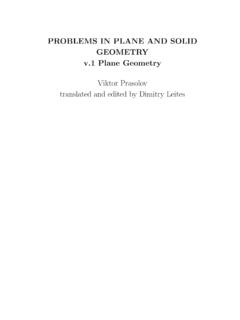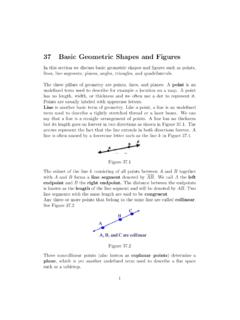Transcription of Geometry Notes – Chapter 1: Essentials of Geometry
1 Geometry Notes Chapter 1: Essentials of Geometry Points, Lines and Planes Segments and Congruence Undefined Terms Ruler Postulate Point A point has no dimension. It is Each point on a number line is assigned a represented by a dot. unique number, called its coordinate. Line A one-dimensional figure that extends The distance between two points is defined without end in two directions. as the absolute value of the difference between of the coordinates of the points. Plane A plane has two dimensions. It is represented by a shape that looks like a floor Segment Addition Postulate or a wall, but it extends without end. If the point B is between points A and C, then the distance from A to B added to the distance from B to C is equal to the distance from A to C.
2 So AB + BC = AC . Defined Terms Segment Part of a line that consists of two endpoints and all the points between them. Midpoint and Distance Formulas Midpoint Ray A ray is part line, part segment. On one end it contains an endpoint; on the other The midpoint of a segment is the point that it extends without end. divides the segment into two congruent segments. So if M is the midpoint of AB , Opposite Rays Two rays that have the then AM MB and AM = MB . same endpoint and extend in opposite directions, thus making a line together. Below, ED and EF are opposite rays. Midpoint Formula Collinear Two or more points that lie on the same The midpoint of two points with the coordinates ( x1 , y1 ) and ( x2 , y2 ) is found by Coplanar Three or more points that lie in the formula the same plane.
3 X1 + x2 y1 + y2 . , . 2 2 . Symbols Object Symbol Distance Formula Line AB AB The distance between two points with the Line Segment AB AB coordinates ( x1 , y1 ) and ( x2 , y2 ) is found by Ray AB AB the formula Distance from A to B AB. ( x2 x1 ) 2 + ( y2 y1 ) 2. Chapter 1 Notes : Essentials of Geometry Page 1 of 3. Geometry Notes Chapter 1: Essentials of Geometry Measure and Classify Angles Angle Pair Relationships Angle Complementary Angles An angle consists of two different rays with Two angles whose sum is 90 degrees. Each the same endpoint. The rays are the sides of angle is the complement of the other. the angle and the endpoint is the vertex of the angle.
4 Supplementary Angles Two angles whose sum is 180 degrees. Each Naming Angles angle is the supplement of the other. The angle below can be named 3 ways: ABC , CBA or simply B . The vertex Adjacent Angles must be the middle letter when using 3. Two angles that share a common vertex and points to name an angle. side, but have no common interior points. Measuring Angles Linear Pair Angles are measured in degrees ( ). In Geometry , angles have measures greater Two adjacent angles form a linear pair if than 0 degrees and up to 180 degrees. their noncommon sides are opposite rays (and thus, form a line). Angles in a linear pair are also supplementary, since a line Classifying Angles makes 180.
5 Acute angle has measure less than 90 . Right angle has measure of 90 . Obtuse angle has measure more than 90 , but less than 180 . Straight angle has measure of 180 . Angle Addition Postulate Vertical Angles If S is in the interior of PQR , then Two intersecting lines form two pairs of m PQS + m SQR = m PQR . vertical angles. In the diagram below, angles 1 and 3 are vertical, as are angles 2 and 4. Chapter 1 Notes : Essentials of Geometry Page 2 of 3. Geometry Notes Chapter 1: Essentials of Geometry Classifying Polygons Perimeter, Circumference and Area Polygon Formulas A polygon is a closed plane figure with at Square least 3 sides.
6 None of the sides may intersect at any other point than their endpoints. P = 4s Each endpoint of the sides of a polygon is A = s2. called a vertex. The plural of vertex is vertices. A polygon is convex if no line that contains Rectangle a side of the polygons contains a point in the interior of the ploygon. A polygon that is not P = 2l + 2 w convex is called concave. A = l iw Triangle P = a+b+c Classifying Polygons by Number of Sides bi h A=. 2. # of Sides Type of Polygon 3 Triangle Circle 4 Quadrilateral 5 Pentagon C = 2i ir 6 Hexagon 7 Heptagon A = ir 2. 8 Octagon 9 Nonagon 10 Decagon ( ). 12 Dodecagon n n-gon Square Unit Conversions An equilateral polygon is one in which all 1 square foot = 144 square inches sides are congruent.
7 1 square yard = 9 square feet An equiangular polygon is one in which all 1 square meter = 10,000 square centimeters angles are congruent. 1 square kilometer = 1,000,000 square A regular polygon is a convex polygon that meters is both equilateral and equiangular. Chapter 1 Notes : Essentials of Geometry Page 3 of 3.






